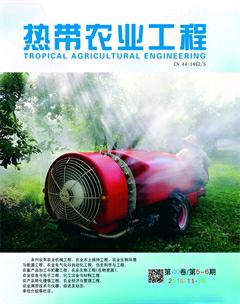琼岛染木树中蒽醌类成分及其抗菌活性研究
吴晓鹏+周学明+张俊燕

摘 要 研究琼岛染木树茎中蒽醌类成分及其抗菌活性。综合运用多种色谱技术对琼岛染木树茎的乙醇提取物进行分离纯化,通过核磁及质谱对所得单体化合物进行结构鉴定,并通过微量稀释法对化合物进行抗菌活性测试,结果表明,从琼岛染木树茎的乙醇提取物中分离得到12个蒽醌类化合物。经鉴定,分别为:(1)虎刺醇;(2)3-羟基-1-甲氧基-2-甲酯基蒽醌;(3)6-羟基-1-甲氧基-2-甲基蒽醌;(4)2-羟基-3-甲基蒽醌;(5)3-羟基-1,2-二甲氧基蒽醌;(6)2-羟基-1-甲氧基蒽醌;(7)1,3-二羟基-2-甲基蒽醌;(8)1,6-二羟基-2-甲基蒽醌;(9)1,3,6-三羟基-2-甲基蒽醌;(10)3-羟基-1-甲氧基-2-甲醚基蒽醌;(11)2-羟甲基-3-羟基蒽醌;(12)3-O-β-primeveroside。抗菌活性表明,大多蒽醌类化合物具有较好的抗菌活性。
关键词 染木树属 ;琼岛染木树 ;蒽醌 ;抗菌活性
中图分类号 O629
Abstract To study the antibacterial anthraquinone derivatives from the stems of Saprosma merrillii Lo. The compounds were isolated and purified by silica gel column, Sephadex LH-20 and Semi-Preparative HPLC. The structures of all compounds were elucidated on the basis of NMR and MS analysis. Antibacterial activity of all compounds was determined by the conventional broth dilution assay. Twelve anthraquinone derivatives were isolated and elucidated as damnacanthol:(1) 3-hydroxy-1-methoxy-2-carbomethoxyanthraquinone;(2) 6-hydroxy-1-methoxy-2-methylanthraquinone;(3) 2-hydroxy-3-methylanthraquinone;(4) 3-hydroxy-1,2-dimethoxyanthraquinone;(5) 2-hydroxy-1-methoxyanthraquinone;(6) 1,3-dihydroxy-2-methylanthraquinone;(7) 1,6-dihydroxy-2-methylanthraquinone;(8) 1,3,6-trihydroxy-2-methylanthraquinone; (9) 3-hydroxy-1-methoxy-2-methyl etheranthraquinone;(10) 2-hydroxymethyl-3-hydroxyanthraquinone;(11) and 3-O-β-primeveroside;(12) All compounds were isolated from this plant for the first time. Many of these compounds showed antibacterial activities.
Key words saprosma ; Saprosma merrillii ; anthraquinone ; antibacterial activities
琼岛染木树(saprosma merrillii)属于茜草科(Rubiaceae)染木树属(saprosma)植物,是海南特有药用植物。染木树属植物作为民间药物已有悠久的历史,主要用于消炎退热、腰腿疼痛的治疗[1]。研究表明,染木树属植物主要含有环烯醚萜苷、生物碱、蒽醌以及三萜类化合物,具有抗氧化、抗菌以及抗肿瘤等多种生物活性[2-6]。本课题组前期从瓊岛染木树中发现了3个新三萜化合物、2个新硫代环烯醚萜苷和1个新酚苷类化合物,然而它们的抗菌活性并不明显[7-9]。为了进一步明确该植物中的抗菌活性成分,本课题组研究人员进一步对其茎的化学成分进行了系统分离。本研究运用活性追踪法对琼岛染木树的乙醇提取物采用多种色谱技术进行分离,通过NMR以及MS等多种波谱技术确定了化合物的结构,并采用微量稀释法对所有化合物进行了7种致病菌的抗菌活性测试。
1 材料与方法
1.1 材料
琼岛染木树茎于2014年6月采自海南省三亚市,经海南师范大学生命科学学院钟琼芯教授鉴定为琼岛染木树。
Bruker AV-400 MHz型核磁共振仪;Finnigan-MAT-95-MS低分辨质谱仪(德国Finnigan公司);安捷伦1260半制备高效液相(Agilent Eclipse XDB-C18柱:9.4×250 mm,5 μm);十八烷基硅胶(12 nm-50 μm)(日本东京YMC公司);葡聚糖凝胶Sephadex LH-20[安法玛西亚技术(上海)有限公司];柱层析硅胶和薄层层析硅胶板(青岛海洋化工厂);色谱试剂均为分析纯。
1.2 方法
1.2.1 化合物萃取、分离与纯化
琼岛染木树干燥的茎(4.5 kg)粉碎成粉末后用85 %的乙醇于室温下浸泡(3×30 L,每次3 d)。过滤浸泡液并减压浓缩得到乙醇浸膏,将乙醇浸膏分散在蒸馏水中再依次用石油醚、乙酸乙酯萃取并减压浓缩得到石油醚部位(60 g)、乙酸乙酯部位(95 g)。将所得的乙酸乙酯部位用100目-200目硅胶拌样,采用硅胶常压柱依次用石油醚-乙酸乙酯(100:0→0:100,V/V)和氯仿-甲醇(2:1→1:1,V/V)进行梯度洗脱。经TLC检测后合并相似流分后得5个组分(Fr.1-5)。Fr.2(15 g)组分用200-300目硅胶拌样上柱用石油醚-乙酸乙酯(15:1,V/V)进行洗脱,经TLC检测后合并相似流分后得3个小组分(Fr.2 a-2 c)。Fr.2 a由半制备高效液相(乙腈:水=60:40,V/V)进行纯化得到化合物3(12 mg)、4(8 mg)以及6(7 mg);Fr.2b由半制备高效液相(甲醇:水=65:35,V/V)进行分离纯化得到化合物2(5 mg)以及化合物11(9 mg)。Fr.3(10 g)组分用200目-300目硅胶拌样上柱用石油醚-乙酸乙酯(8:1,V/V)进行洗脱,经TLC检测后合并相似流分后得3个小组分(Fr.3 a-3 c)。Fr.3a由凝胶柱(氯仿:甲醇=1:1,V/V)纯化后得到化合物8(21 mg)。Fr.3 b由半制备高效液相(乙腈:水=51:49,V/V)进行分离纯化得到化合物1(6 mg)、化合物5(8 mg)以及化合物7(9 mg)。Fr.3 c由凝胶柱(氯仿:甲醇=1:1,V/V)除色素后再由半制备高效液相(乙腈:水=45:55,V/V)进行分离纯化得到化合物9(9 mg)以及化合物10(3 mg)。Fr.5(8 g)组分由ODS柱(甲醇:水=20:80,V/V)纯化分离得到化合物12(10 mg)。
1.2.2 抗菌活性测试
采用微量稀释法[10]对所有化合物进行了抗菌活性测试,供试细菌为金黄色葡萄球菌(Staphylococcus aureus)、枯草芽孢杆菌(Bacillus subtilis)、四联球菌(Micrococcus tetragenus)、白色葡萄球菌(Staphylococcus albus)、大肠杆菌(Escherichia coli)、 藤黄八叠球菌(Micrococcus luteus)和蜡状芽孢杆菌(Bacillus cereus)7种。
2 结果与分析
2.1 结构鉴定
2.1.1 化合物1
淡黄色针晶(甲醇),mp 292-294 ℃。ESI-MS:m/z 307[M+Na]+。1H-NMR(DMSO-d6,400 MHz)δ:8.14(1H,d,J= 8.0 Hz,H-8),8.09(1H,d,J=8.0 Hz,H-5),7.88(1H,dd,J=8.0,8.0 Hz,H-7),7.83(1H,dd,J=8.0,8.0 Hz,H-6),7.50(1H,s,H-4),4.56(2H,s,H-15),3.85(3H,s,1-OCH3);13C-NMR(DMSO-d6,100 MHz)δ:182.5(C-10),180.0(C-9),162.1(C-3),161.7(C-1),135.4(C-4a),134.6(C-7,8a),133.3(C-6),132.0 (C-10a),128.8(C-2),126.7(C-8),126.1(C-5),117.9(C-9a),109.8(C-4),62.4(5-OCH3),52.2(C-15)。以上数据与文献[11]报道的虎刺醇一致,故鉴定化合物1为虎刺醇。
2.1.2 化合物2
淡黄色粉末(甲醇),mp 311-313 ℃。ESI-MS:m/z 335 [M+Na]+。1H-NMR(DMSO-d6,400 MHz)δ:8.14 (2H,d,J=7.6 Hz,H-5,8),7.80(2H,d,J=7.6 Hz,H-6,7),7.56(1H,s,H-4),3.86(3H,s,11-OCH3),3.84(3H,s,1-OCH3);13C-NMR(DMSO-d6,100 MHz)δ:182.1(C-10),179.6(C-9),164.9(C-11),159.6(C-3),159.5(C-1),136.9(C-4a),134.7(C-6),134.7(C-6),134.3(C-10a),133.6(C-7),132.0(C-8a),126.7(C-8),126.3(C-5),123.3(C-2),117.7(C-9a),110.1(C-4),62.6(1-OCH3),52.4(11-OCH3)。以上数据与文献[12]报道的3-羟基-1-甲氧基-2-甲酯基蒽醌一致,故鉴定化合物2为3-羟基-1-甲氧基-2-甲酯基蒽醌。
2.1.3 化合物3
淡黄色粉末(甲醇),mp 295-297 ℃。ESI-MS: m/z 291[M+Na]+。1H-NMR(DMSO-d6,400 MHz)δ:13.19(1H,s,6-OH),8.23(1H,d,J=8.0 Hz,H-8),7.66(1H,d,J=7.2 Hz,H-4),7.64(1H,d,J=7.2 Hz,H-3),7.63(1H,s,H-5),7.34(1H,d,J=8.0 Hz,H-7),3.90(3H,s,1-OCH3),2.34(3H,s,2-CH3);13C-NMR(DMSO-d6,100 MHz) δ:189.6(C-9),182.2(C-10),164.5(C-1),161.7(C-6),137.7(C-9a),137.2(C-4a),135.4(C-3),132.7(C-2),130.7(C-8),126.6(C-8a),122.1(C-7),119.5(C-4),116.0(C-10a),113.6(C-5),123.3(C-2),117.7(C-9a),110.1(C-4),56.7(1-OCH3),16.0(2-CH3)。以上数据与文献[13]报道的6-羟基-1-甲氧基-2-甲基蒽醌一致,故鉴定化合物3为6-羟基-1-甲氧基-2-甲基蒽醌。
2.1.4 化合物4
淡黄色粉末(甲醇),mp 299-301 ℃。ESI-M:m/z 261[M+Na]+。1H-NMR(Acetone-d6,400 MHz) δ:8.16(1H,d,J=8.0 Hz,H-8),8.13(1H,d,J=8.0 Hz,H-5),7.93(1H,s,H-4),7.88(1H,dd,J=8.0,8.0 Hz,H-7),7.84(1H,dd,J=8.0,8.0 Hz,H-6),7.50(1H,s,H-1),2.24(3H,s,3-CH3);13C-NMR(Acetone-d6,100 MHz)δ:182.6(C-9),181.3(C-10),161.4(C-2),133.7(C-6),133.6(C-8a),133.5(C-4 a,10 a),134.1(C-7),132.0(C-9 a),130.0(C-3),126.7(C-8),126.5(C-5),125.5(C-4),111.4(C-1),16.5(2-CH3)。以上数据与文献[14]的2-羟基-3-甲基蒽醌报道一致,故鉴定化合物4为2-羟基-3-甲基蒽醌。
2.1.5 化合物5
淡黄色针晶(甲醇),mp 235-237 ℃。ESI-M:m/z 307[M+Na]+。1H-NMR(Acetone-d6,400 MHz)δ:8.12(1H,d,J=7.6 Hz,H-8),8.10(1H,d,J=7.6 Hz,H-5),7.88(1H,dd,J=7.6,7.6 Hz,H-7),7.83(1H,dd,J=7.6,7.6 Hz,H-6),7.52(1H,s,H-4),3.86(3H,s,1-OCH3),3.83(3H,s,2-OCH3);13C-NMR(Acetone-d6,100 MHz)δ:181.5(C-10),179.7(C-9),155.7(C-3),154.5(C-1),146.5(C-2),134.1(C-8a),133.9(C-7),132.9(C-6),131.5(C-10 a),129.8(C-4 a),126.0(C-8),125.5(C-5),118.7(C-9 a),110.3(C-4),60.7(1-OCH3),60.1(2-OCH3)。以上數据与文献[15]的3-羟基-1,2-二甲氧基蒽醌报道一致,故鉴定化合物5为3-羟基-1,2-二甲氧基蒽醌。
2.1.6 化合物6
淡黄色粉末(甲醇),mp 178-179 ℃。ESI-M:m/z 277[M+Na]+。1H-NMR(CD3OD,400 MHz)δ:8.56(1H,d,J=8.0 Hz,H-3),8.32(1H,d,J=8.0 Hz,H-5),8.30(1H,d,J=8.0 Hz,H-8),8.10(1H,d,J=8.0 Hz,H-4),7.82(1H,dd,J=8.0,8.0 Hz,H-7),7.80(1H,dd,J=8.0,8.0 Hz,H-6),4.00(3H,s,1-OCH3);13C-NMR(CD3OD,100 MHz)δ:182.7(C-9),182.1(C-10),155.6(C-2),146.6(C-1),134.5(C-8 a),133.9(C-6,7),132.9(C-4 a),127.5(C-10 a),127.1(C-5),126.9(C-8),125.8(C-4),125.7(C-9 a),120.3(C-3),62.3(1-OCH3)。以上数据与文献[16]报道的2-羟基-1-甲氧基蒽醌一致,故鉴定化合物6为2-羟基-1-甲氧基蒽醌。
2.1.7 化合物7
淡黄色粉末(甲醇),mp 291-292 ℃。ESI-MS:m/z 277[M+Na]+。1H-NMR(Acetone-d6,400 MHz)δ:13.22(1H,s,1-OH),8.29(1H,d,J=8.0 Hz,H-8),8.21(1H,d,J=8.0 Hz,H-5),7.91(1H,dd,J=8.0,8.0 Hz,H-7),7.90(1H,dd,J=8.0,8.0 Hz,H-6),7.36(1H,s,H-4),2.18(3H,s,2-CH3);13C-NMR(Acetone-d6,100 MHz)δ:187.6(C-9),182.7(C-10),164.2(C-3),163.4(C-1),135.1(C-7),134.9(C-6),134.4(C-8 a),133.3(C-10 a),132.4(C-4 a),127.7(C-5),127.4(C-8),118.9(C-2),110.7(C-9 a),108.1(C-4),8.2(2-CH3)。以上数据与文献[17]报道的1,3-二羟基-2-甲基蒽醌一致,故鉴定化合物7为1,3-二羟基-2-甲基蒽醌。
2.1.8 化合物8
淡黄色粉末(甲醇),mp 287-289 ℃。ESI-MS:m/z 277[M+Na]+。1H-NMR(Acetone-d6,400 MHz)δ:13.19(1H,s,1-OH),8.23(1H,d,J=8.0 Hz,H-8),7.66(1H,d,J=8.0 Hz,H-4),7.64(1H,d,J=8.0 Hz,H-3),7.63(1H,s,H-5),7.34(1H,d,J=8.0 Hz,H-7),2.34(3H,s,2-CH3);13C-NMR(Acetone-d6,100 MHz)δ:189.6(C-9),182.2(C-10),164.5(C-1),161.7(C-6),137.7(C-9 a),137.2(C-4 a),135.4(C-3),134.4 (C-8 a),132.7(C-2),130.7(C-8),126.6(C-8 a),122.1(C-7),119.5(C-4),116.0(C-10 a),113.6(C-5),16.0(2-CH3)。以上数据与文献[18]报道的1,6-二羟基-2-甲基蒽醌一致,故鉴定化合物8为1,6-二羟基-2-甲基蒽醌。
2.1.9 化合物9
淡黄色粉末(甲醇),mp 238-239 ℃。ESI-MS: m/z 293[M+Na]+。1H-NMR(Acetone-d6,400 MHz)δ:7.99(1H,d,J=8.4 Hz,H-8),7.39(1H,d,J=2.8 Hz,H-5),7.07(1H,dd,J=8.4,2.8 Hz,H-7),7.06(1H,s,H-4),2.05(3H,s,2-CH3);13C-NMR(Acetone-d6,100 MHz)δ:187.4(C-9),183.8(C-10),164.4(C-3),164.0(C-1),163.4(C-6),133.5(C-4 a,10 a),130.4(C-8),126.8(C-8 a),122.0(C-7),119.4(C-2),113.6(C-5),109.3(C-9 a),108.0(C-4),8.2(2-CH3)。以上数据与文献[19]报道的1,3,6,-三羟基-2-甲基蒽醌一致,故鉴定化合物9为1,3,6,-三羟基-2-甲基蒽醌。
2.1.10 化合物10
淡黄色粉末(甲醇),mp 195-196 ℃。ESI-MS:m/z 321[M+Na]+。1H-NMR(Acetone-d6,400 MHz)δ:8.26(1H,d,J=8.4 Hz,H-8),8.24(1H,d,J=8.4 Hz,H-5),7.78(1H,dd,J=8.4,8.0 Hz,H-7),7.76(1H,dd,J=8.4,8.0 Hz,H-6),7.61(1H,s,H-4),4.97(2H,s,H-11),3.91(3H,s,11-OCH3),3.56(3H,s,1-OCH3);13C-NMR(Acetone-d6,100 MHz)δ:182.9(C-9),181.2(C-10),162.7(C-1),160.1(C-3),136.6(C-8 a),135.0(C-10 a),134.4(C-4 a),133.4(C-8),132.8(C-6),127.3 (C-7),126.8(C-5),122.5(C-9 a),118.7(C-2),112.5(C-4),69.5(C-11),62.2(11-OCH3),59.4 (1-OCH3)。以上數据与文献[20]报道的3-羟基-1-甲氧基-2-甲醚基蒽醌一致,故鉴定化合物10为3-羟基-1-甲氧基-2-甲醚基蒽醌。
2.1.11 化合物11
淡黄色粉末(甲醇),mp 225-227 ℃。ESI-MS:m/z 277[M+Na]+。1H-NMR (Acetone-d6,400 MHz)δ:8.25(1H,s,H-4),8.20(2H,m,H-6,7),7.89(2H,m,H-5,8),7.53(1H,s,H-1),4.60(2H,s,C-11);13C-NMR (Acetone-d6,100 MHz)δ:182.7(C-9),181.4(C-10),160.1(C-3),136.4(C-8 a),134.4(C-7),133.9(C-6),133.4(C-4 a),133.3(C-10 a),133.1(C-9 a),126.6(C-5),126.5(C-8),126.2(C-1),118.7(C-9 a),124.8(C-2),111.3(C-4),57.7(C-11)。以上数据与文献[21]报道的2-羟甲基-3-羟基蒽醌一致,故鉴定化合物11为2-羟甲基-3-羟基蒽醌。
2.1.12 化合物12
淡黄色粉末(甲醇),mp 211-212 ℃。ESI-MS:m/z 587[M+Na]+。1H-NMR(Acetone-d6,400 MHz)δ:13.06(1H,s,1-OH),8.25(1H,dd,J=8.0, 2.0 Hz,H-8),8.24(1H,dd,J=8.0,2.0 Hz,H-5),8.19(1H,m,H-7),8.17(1H,m,H-6),7.18(1H,s,H-4),5.14(1H,d,J=7.6 Hz,H-1'),4.62(2H,s,H-11),4.15(1H,d,J=7.2 Hz,H-1"),3.94(1H,d,J=9.2 Hz,H-6'a),3.69(2H,m,H-5',5"),3.68(1H,m,H-6'b),3.55(2H,m,H-4',4"),3.22(2H,m,H-3',3"),2.99(2H,m,H-2',2");13C-NMR (Acetone-d6,100 MHz)δ:187.6(C-9),182.0(C-10),162.4(C-1),162.3(C-3),135.3(C-7),135.2(C-6),134.2(C-10 a),133.4(C-4 a),133.2(C-8 a),127.3(C-8),127.0(C-5),123.9(C-2),111.8(C-9 a),106.8(C-4),104.5(C-4"),101.1(C-1'),76.9(C-5'),76.2(C-3'),76.1(C-3"),73.7(C-2',2"),69.9(C-4"),69.5(C-4'),68.4(C-6'),66.1(C-5"),51.4(C-11)。以上數据与文献[22]报道的lucidin 3-O-β-primeveroside一致,故鉴定化合物12为lucidin 3-O-β-primeveroside。
2.2 抗菌活性
由表1可知,化合物3对金黄色葡萄球菌有较好的抑制活性,其最小抑菌浓度MIC为1.25 μg/mL;化合物5对藤黄微球菌有较好的抑制活性,其MIC为1.25 μg/mL;化合物6对蜡状芽胞杆菌有较好的抑制活性,其MIC为1.25 μg/mL;化合物7对大肠杆菌有较好的抑制活性,其MIC为1.25 μg/mL。
3 结论
本研究综合运用多种色谱技术对琼岛染木树茎的乙醇提取物进行分离纯化,通过核磁及质谱对所得单体化合物进行结构鉴定及通过微量稀释法对化合物进行抗菌活性测试,结果表明,从琼岛染木树茎的乙醇提取物中分离得到12个蒽醌类化合物。经鉴定,分别为:(1)虎刺醇;(2)3-羟基-1-甲氧基-2-甲酯基蒽醌;(3)6-羟基-1-甲氧基-2-甲基蒽醌;(4)2-羟基-3-甲基蒽醌;(5)3-羟基-1,2-二甲氧基蒽醌;(6)2-羟基-1-甲氧基蒽醌;(7)1,3-二羟基-2-甲基蒽醌;(8)1,6-二羟基-2-甲基蒽醌;(9)1,3,6-三羟基-2-甲基蒽醌;(10)3-羟基-1-甲氧基-2-甲醚基蒽醌;(11)2-羟甲基-3-羟基蒽醌;(12)3-O-β-primeveroside。抗菌活性表明,蒽醌类化合物具有较好的抗菌活性。
参考文献
[1] Chen S K, Chen B Y, Li H. Flora of China (Vol. 44)[M]. Beijing: Science Press, 1997: 67.
[2] Wang L, Chen G Y, Han C R, et al. Two novel alkaloids from the stem of Saprosma hainanense and their cytotoxic activities in vitro[J]. ChemInform, 2011, 59(34): 338-40.
[3] Ling S K, Komorita A, Tanaka T, et al. Sulfur-containing bis-iridoid glucosides and iridoid glucosides from Saprosmas cortechinii[J]. Journal of Natural Products, 2002, 65(5): 656-660.
[4] Lu X L, Cao X, Liu X Y, et al. Iridoid glycosides from Saprosma ternatum[J]. Planta Medica, 2010, 76(15): 1 746-1 748.
[5] Li S R, Yang H, Tan C, et al. Chemical constituents of ethyl acetate fraction from the stems of Saprosma merrillii Lo[J]. Journal of Chinese Pharmaceutical Sciences, 2015, 50(12): 1 017-1 020.
[6] Zhang D S, Chen W H, Chen G Y, et al. Chemical constituents from the stems of Saprosma merrillii Lo[J]. Journal of Chinese Pharmaceutical Sciences, 2013, 48(12): 964-967.
[7] Zhang D, Chen W, Chen W, et al. Three new ursane-type triterpenoids from the stems of Saprosma merrillii[J]. Molecules, 2013, 18(18): 14 496-14 504.
[8] Zhou X M, Zheng C J, Li G N, et al. Two new sulfur-containing iridoid glucosides from Saprosma merrillii[J]. Phytochemistry Letters, 2016, 17: 50-54.
[9] Zhou X M, Zheng C J, Song X P, et al. A new phenolic glycoside from Saprosma merrillii[J]. Natural Product Research, 2016, 30(21):1-5.
[10] Pierce C G, Uppuluri P, Tristan A R, et al. A simple and reproducible 96-well plate-based method for the formation of fungal biofilms and its application to antifungal susceptibility testing[J]. Nature Protocols, 2008, 3(9): 1 494-1 500.
[11] Konoshima T, Kozuka M, Koyama J, et al. Studies on inhibitors of skin tumor promotion, VI. Inhibitory effects of quinones on Epsterin-Barr virus activation[J]. Journal of Natural Products, 1989, 52(5): 987-995.
[12] Ling S K, Komorita A, Tanaka T, et al. Iridoids and anthraquinones from the Malaysian medicinal plant, Saprosma merrillii (Rubiaceae)[J]. ChemInform, 2003, 50(2): 1 035-1 040.
[13] Sittie A A, Lemmich E, Olsen C E, et al. Structure-activity studies: in vitro antileishmanial and antimalarial activities of anthraquinones from Morinda lucida[J]. Planta Medica, 1999, 65(3): 259-261.
[14] Huang W H, Li Y B, Jiang J Q. Chemical constituents from Hedyotis diffusa[J]. China Journal of Chinese Materia Medica, 2009, 34(5): 712-714.
[15] Wang Y, Chen W, Chen G, et al. Anthraquinones from the leaves of Saprosma hainanense[J]. Chinese Journal of Organic Chemistry, 2014, 34(3): 522.
[16] Kuiper J, Labadie R P. Polyploid complexes within the genus Galium[J]. Planta Medica, 1983, 48(42): 390-399.
[17] Fan W Q. Chemical constituents of Alternanthera philoxeroides[J]. Chinese Journal of Natural Medicines, 2008, 6(2): 112-115.
[18] Bowie, J H, Cooke, R G. Colouring matters of Australian plants. IX. Anthraquinones from Morinda species[J]. Australian Journal of Chemistry, 1962, 15(2): 332-335.
[19] Itokawa H, Mihara K, Takeya K. Studies on a novel anthraquinone and its glycosides isolated from Rubia cordifolia and R. akane[J]. Chemical & Pharmaceutical Bulletin, 1983, 31(7): 2 353-2 358.
[20] Ferrari F, Monache G D, Lima R A D. Two naphthopyran derivatives from Faramea cyanea[J]. Phytochemistry, 1985, 24(24): 2 753-2 755.
[21] Wu Y B, Zheng C J, Qin L P, et al. Antiosteoporotic activity of anthraquinones from Morinda officinalis on osteoblasts and osteoclasts[J]. Molecules (Basel, Switzerland), 2008, 14(1): 573-83.
[22] Hao J, Feng S X, Qiu S X, et al. Anthraquinone Glycosides from the roots of Prismatomeris connata[J]. Chinese Journal of Natural Medicines, 2011, 9(1): 42-45.

